For the year or two before moving to Cincinnati, I ran a class at my school on veneer and inlay (I’m running one in 2019, click here and use the coupon code day3 for a 10% discount off the class – valid for 72 hours). As part of the class, I had the students make string inlay tools. I took lots of photos when I made the prototypes before introducing the project to my classes.
The tools themselves are relatively simple to make; they’re specialized marking gauges. Most of the original gauges I’ve seen use wedges to lock their fences in place. I decided to add threaded inserts and knurled knobs (both of which you can purchase through Rockler). I figured this would make adjusting the fence position much easier than using a wedge. Besides, I had made a cutting gauge when I was in my teens that had a wedge; wedges can come loose. Spend the extra couple of bucks and get a knurled knob.
Sting Inlay Tools, Where To Start
I used scrap maple left over from a job (mine happened to be birdseye, but you can use anything you like). I started with a simple drawing of the gauge I wanted and figured I’d modify it in process. Using a piece of wood about 40” long I could make multiple tools (the board ended up producing ten gauges). If you want to make only one, you’ll need less stock.
 Start by making the fence stock. Mill the material to 7/8″ thick, then rip the board to 2 – 1/2”, which is the height of the fence.
Start by making the fence stock. Mill the material to 7/8″ thick, then rip the board to 2 – 1/2”, which is the height of the fence.
The next step is to mill the mortise for the beam. The beam is 7/16” thick by 1 – 1/4” wide. Make a simple jig that positions the mortise exactly in the center of the 4″ fence and 7/8″ from the bottom edge.
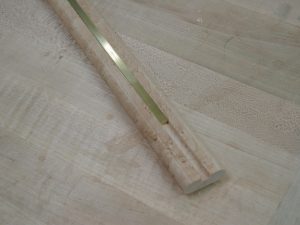 Next, mill the beam material (I made the beams 4 – 1/2″ long), then set up the router table with a 1/4″ quarter round bit. Run both top and bottom surfaces of both edges, adjust the width of the beam with a hand plane until it fits snugly into the fence mortise.
Next, mill the beam material (I made the beams 4 – 1/2″ long), then set up the router table with a 1/4″ quarter round bit. Run both top and bottom surfaces of both edges, adjust the width of the beam with a hand plane until it fits snugly into the fence mortise.
After milling the material for the beams to shape, cut a 1/4″ wide groove the length of the material to receive the brass rub strip. I used a 1/4″ end mill. You’ll see in the photo that the 1/8″ by 1/4″ brass strip fits perfectly into the groove.
 Take the fence stock to the table saw, and set it up with a flat top rip blade set tight against a sacrificial fence. Cut a rabbet into the fence stock to receive the 1/8″ by 3/4″ brass rub strip. I used a flat top rip blade to ensure the rabbet was cut cleanly into the corner.
Take the fence stock to the table saw, and set it up with a flat top rip blade set tight against a sacrificial fence. Cut a rabbet into the fence stock to receive the 1/8″ by 3/4″ brass rub strip. I used a flat top rip blade to ensure the rabbet was cut cleanly into the corner.
Final Size
 Now that all the milling is complete, it’s time to cut the fence and beam stock to length. Use a sled on the table saw, and set a stop block at the proper distance from the blade. Notice in the photo how I use an awl as a push stick to hold onto the piece between the blade and the stop block. At only 4 – 1/2″ the distance is a bit too tight to fit my hand safely in the space. The awl does a great job of holding the material firmly in place while keeping my fingers attached.
Now that all the milling is complete, it’s time to cut the fence and beam stock to length. Use a sled on the table saw, and set a stop block at the proper distance from the blade. Notice in the photo how I use an awl as a push stick to hold onto the piece between the blade and the stop block. At only 4 – 1/2″ the distance is a bit too tight to fit my hand safely in the space. The awl does a great job of holding the material firmly in place while keeping my fingers attached.
With the beams and fences complete, it’s time for the brass rub strips. Brass is a soft material and, while it’s not ideal, it can be cut using carbide tipped woodworking tools. If you plan on using a metal other than brass, you should plan accordingly.
Set up a stop block on the power miter box and cut the strips to length. I saved lots of time and aggravation by purchasing three different size pieces of brass stock for these tools. All three brass bars were 1/8″ thick but the widths varied. I purchased one length each of 1/4″, 1/2″ and 3/4″ brass bar stock from McMaster – Carr. Here is a link.
Add The Brass
Now it’s time to head to the drill press to drill the holes in the fence material for the threaded inserts, and in all the brass parts for the screws that attach them to the tools. From Rockler I purchased 1/4″ #20 brass threaded inserts as well as 1/4″ #20 knurled knobs. Using a fence on the drill press, drill the hole for the threaded inserts.
Next, set up to drill the fence rub strips and the clamp at the end of the beam, which holds the cutting tools. I used 5/8″ #5 flat head brass woodscrews to attach all my parts except the 1/4″ rub strip in the beam; I epoxied it into place.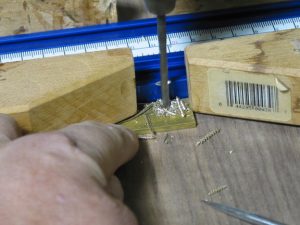
With all the holes drilled, install the threaded brass inserts into the fence material. Then layout the shape of the fence. In my original drawing, I had the fence drawn in at around 6″ in length. I decided that 4″ suited my hand better. Once I sketched out a shape I liked, I headed to the bandsaw to cut out the fences.
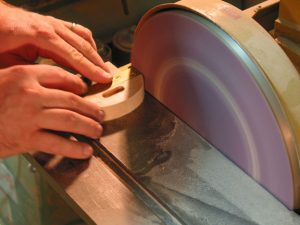 Leave the material rough sawn from the bandsaw, and head back to the bench to attach the rub strip to the fence. At this point, the wooden fence is only roughed out, and the brass rub strip is rough length.
Leave the material rough sawn from the bandsaw, and head back to the bench to attach the rub strip to the fence. At this point, the wooden fence is only roughed out, and the brass rub strip is rough length.
Take the rough fence assembly to the disc sander and sand it to shape. Sanding the fence with the rub strip in place allows you to make modifications to the shape on the fly. Work it until it fits your hand comfortably.
 Once you complete the shaping on the disc sander, you can turn the fence on edge and sand the face. Afterward, you’ll have to hand sand with a block and paper to get the proper finish. I used an edge sander to smooth things up and make all the surfaces flush.
Once you complete the shaping on the disc sander, you can turn the fence on edge and sand the face. Afterward, you’ll have to hand sand with a block and paper to get the proper finish. I used an edge sander to smooth things up and make all the surfaces flush.
The only things left to do are grind the clamp on the end of the beam to shape, polish up all the brass and attach my cutters. You’ll need to use a simple jig to grind the clamp safely because it is so small. The jig consists of a board into which a #5 wood screw is inserted about 3/16″ from the end.
Cut off the head of the wood screw and used it as a pivot point to grind the clamp to size and shape. Be sure to clamp the jig securely to the sander table.
Versatile String Inlay Tools
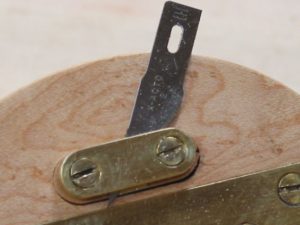 Once everything is sanded, buffed and finished, make the cutters. To make the gauge into a slicer, for cutting the stringing, use an Exacto knife blade. In order to cut the groove for the stringing, there are two problems to tackle.
Once everything is sanded, buffed and finished, make the cutters. To make the gauge into a slicer, for cutting the stringing, use an Exacto knife blade. In order to cut the groove for the stringing, there are two problems to tackle.
The first is how to make the groove. It has always been my contention that many early craftsmen used scratch stocks for many varied purposes. String inlay is ideally suited to a scratch stock. For the cutter, I used a drill bit. This way you can control the exact width of the groove. The bit is hardened so it will hold a sharpened edge.
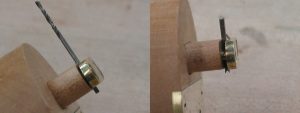 The second problem to solve is, the groover didn’t work very well across the grain. Rather than try to set the slicer up to score the interior and exterior lines of the cross grain, I decided to make a pair of scoring cutters. For me, the bulk of the stringing I do measures 1/16″. I cut two small strips from a card scraper, beveled them and then sandwiched them together in the clamp. My card scraper material measures a pretty accurate 1/32″ thick. By sandwiching them together, I get a perfect 1/16″ score line. Once I’ve scored the piece of wood, I take the gauge with the drill bit and remove the waste.
The second problem to solve is, the groover didn’t work very well across the grain. Rather than try to set the slicer up to score the interior and exterior lines of the cross grain, I decided to make a pair of scoring cutters. For me, the bulk of the stringing I do measures 1/16″. I cut two small strips from a card scraper, beveled them and then sandwiched them together in the clamp. My card scraper material measures a pretty accurate 1/32″ thick. By sandwiching them together, I get a perfect 1/16″ score line. Once I’ve scored the piece of wood, I take the gauge with the drill bit and remove the waste.



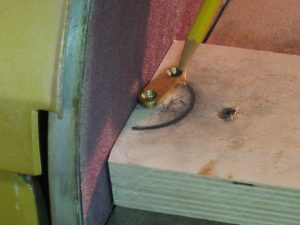
I have made a couple of these tools from Chuck’s class, and still use them. The screws holding the brass end cap on the sliding beam did become a bit loose because they are going into end grain. I solved this by adding a little glue to the predrilled holes.
Bob Emmons
Did you over-tighten the screws?
Thanks for this article – I made one and it works a treat. Due to the lockdown situation I ended up making my own brass hardware too (yes even the threaded insert) so the only think I bought was a Swann-Morton 11 scalpel blade!
Thanks, Alan. Glad you enjoyed the blog and you had fun during the Covid-19 lockdown. Email me pics if you have them, I’d love to see what you made.